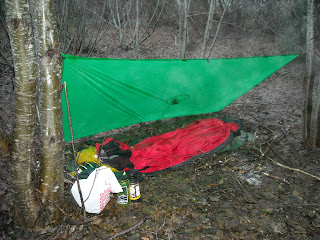
The SteriPEN is not a filter, it's a device that purifies water by using ultra-violet light to disrupt the DNA in the various microbes that might be lurking in the water. If the water is cloudy, you'd want to use a pre-filter to get the large gunk out (I plan on using coffee filters for this), but in the case of a clear running stream like this one, the SteriPEN and a bottle is all you need.
The SteriPEN Classic

The really great thing about the SteriPEN is that it is fast and simple to use. You take off the protective cap, press the button twice for a 0.5 liter bottle or once for a 1.0 liter bottle, wait for the green light to flash and then push the bulb into the bottle. The nose of the SteriPEN wedges into a small mouth bottle or you can use it as a stirrer in a wide mouth bottle. You swirl the water around while the light zaps the nasty critters that may lurk in the water. The entire process takes 48 seconds for a half-liter or 90 seconds for a full liter.


Unlike chemical purifiers, there is no long wait and the taste of the water is unchanged. At a minute and half per liter of water, the SteriPEN is faster than any filter I've used. Again, if the water is murky I will use a pre-filter, but the SteriPEN is quite handy. And being able to drink that cool, mountain stream water within a couple of minutes of coming to the creek is a priceless joy.

To really do things right, you should carry some kind of pre-filter and be careful to keep your lips off the "unclean" outer portion of the bottle. And in case of battery or other electronic failure, I carry a small stash of Chlorine Dioxide MicroPur Tablets
My bike headlight
My devices don't need to have their batteries charged every day but I since I may be away from power outlets for days at a time, I've added a couple of
UltraLast Green Solar 2 AA Chargers

These small chargers sit in my kitchen window at home, soaking up the sun and charging the batteries that I then swap into whatever device happens to be running low. On my back country trips, I pack the chargers in clear Dry Pak cases
Returning to the SteriPEN, both Mark and I have been favorably impressed with the ease and speed of the device. Mark pointed out that the protective cap for the SteriPEN's bulb could be easily lost, so I'll be making a small leash to keep the cap attached to the SteriPEN and its neoprene case.
Keep 'em rolling,
Kent "Mountain Turtle" Peterson













